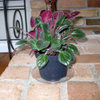Columnea question
tjsangel
18 years ago
Hi,
This may sound stupid, but here goes. I have a small Columnea banksii (sp?) It's in a 4 inch pot. My question is, how big do they have to be to flower, and do they flower all year? Mine hasnt gotten buds yet but I've only had it a few months. I keep it in bright morning sun. Thanks!
Jen

irina_co
stonesriver
Related Professionals
Foothill Ranch Landscape Architects & Landscape Designers · Fairhope Landscape Contractors · Farmington Landscape Contractors · Hurricane Landscape Contractors · Lynn Landscape Contractors · Monterey Landscape Contractors · North Haven Landscape Contractors · Pleasant Hill Landscape Contractors · Ronkonkoma Landscape Contractors · Stallings Landscape Contractors · San Pablo Landscape Contractors · Four Corners Siding & Exteriors · Levittown Siding & Exteriors · Longmont Siding & Exteriors · Wheeling Siding & Exteriorsirina_co
stonesriver
irina_co
jon_d
irina_co
stonesriver
irina_co
jon_d
jon_d
irina_co
jon_d
irina_co
jon_d
irina_co
stonesriver
jon_d